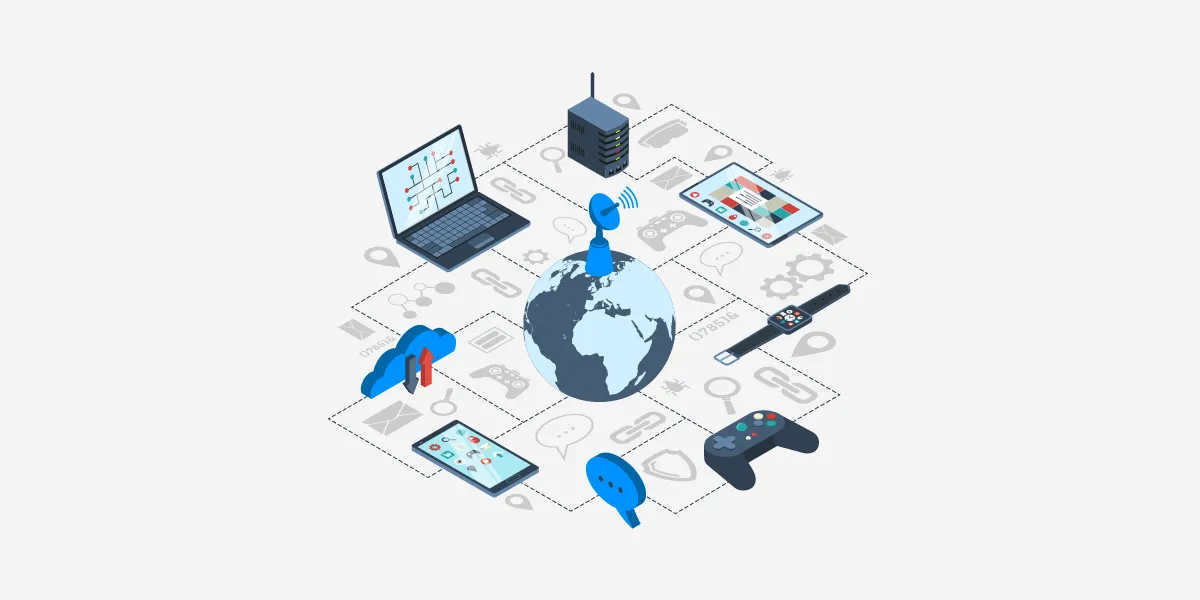The Evolution of IoT Apps: Creating Real-Time, Connected Enterprise Systems
Over the past decade, Internet of Things (IoT) applications have evolved, moving far beyond smart thermostats and connected watches. Businesses are now building intelligent systems that communicate in real-time across factories, hospitals, cities, and farms. With billions of devices generating data around the clock, enterprises are beginning to rethink how they operate, serve customers, and plan for growth.
As IoT systems grow in scale and complexity, the demand for reliable, scalable, and responsive applications has surged. That’s why IoT app development experts are focusing on building robust solutions that allow devices to talk, respond, and adapt instantly. This blog explores how IoT applications have evolved, what’s driving real-time connectivity, and how enterprises can build truly connected ecosystems.
From Sensors to Systems: The Journey of IoT Applications
When IoT first entered the mainstream, most implementations were limited in scope. Consider a device that collects temperature data or motion sensors, which only records logs. These early systems were largely passive, gathering information without enabling real-time action or decision-making.
Over time, this changed. Enterprises began connecting multiple devices, enabling two-way communication, and developing platforms that could process inputs and generate actionable insights. Suddenly, devices were no longer just data sources; they became active participants in operations. IoT apps evolved from basic dashboards into intelligent hubs that could detect, analyze, and respond.
Today, modern IoT apps don’t just collect data. They create dynamic systems that adapt to real-world inputs in real-time.
Why Real-Time Matters More Than Ever
In enterprise environments, seconds can mean millions. If a power plant’s sensors detect overheating or if a logistics company notices delays in vehicle routes, a timely response is critical. Real-time data ensures that businesses not only monitor their operations but also control and optimize them as events unfold.
So, what changed?
- Expectations shifted: Business leaders want instant insights, not weekly reports.
- Edge computing has grown: Devices now process data locally before sending it to the cloud, enabling quicker decision-making.
- AI integration became viable: Models embedded in devices can now detect anomalies or predict failures.
- Network latency has improved: With advancements in 5G and wireless protocols, communication between devices and platforms has become faster and more reliable.
All these developments brought real-time connectivity from a wishful thought to a standard practice.
How Today’s Enterprises Use IoT Apps
Let’s take a quick look at how modern businesses are using IoT applications across industries:
- Manufacturing: Smart factories use connected machines to monitor production lines, detect issues, and schedule maintenance without manual intervention.
- Healthcare: Wearables and smart sensors track patient vitals and alert providers before emergencies occur.
- Agriculture: IoT sensors measure soil health, irrigation levels, and weather conditions to improve crop yield.
- Retail: Stores track inventory movement in real-time to avoid overstocking or understocking.
- Transportation: Fleet management systems optimize routes, monitor driver behavior, and reduce fuel costs.
Each of these scenarios depends on real-time data and responsive systems. Without the ability to act immediately, the value of connectivity diminishes.
Building Blocks of Real-Time IoT Applications
To create enterprise-grade IoT systems, businesses need more than just devices and dashboards. Here’s what goes into building applications that are truly real-time and connected:
1. Scalable Data Architecture
IoT ecosystems generate massive data streams from hundreds of sensors, devices, and endpoints. Systems must be built to scale horizontally and handle spikes in traffic without failures.
- Use message brokers like MQTT or Apache Kafka for reliable communication.
- Employ time-series databases for storing and querying sensor data efficiently.
- Design for event-driven architectures to enable real-time processing.
2. Edge and Fog Computing
Instead of sending all data to the cloud, edge computing enables processing at the source, reducing latency and conserving bandwidth.
- Place intelligence on the device level.
- Use fog computing for intermediate processing when edge capacity is limited.
- Ensure edge nodes can function offline or with intermittent connectivity.
3. Interoperability and Protocol Support
Devices from different manufacturers use different communication protocols. A robust IoT application supports integration across multiple formats.
- Common protocols include MQTT, CoAP, HTTP, and OPC-UA.
- Implement a gateway that can translate and normalize data across devices.
4. Security and Identity Management
Connected systems are vulnerable. A single unsecured device can put the entire enterprise at risk.
- Use TLS encryption for device-to-cloud communication.
- Implement authentication for all endpoints.
- Enable role-based access and device provisioning.
IoT and AI: A Natural Integration
Real-time systems become even more powerful when paired with machine learning. By feeding data from sensors into trained models, IoT applications can evolve from reactive to predictive systems.
Some real-world applications include:
- Predictive maintenance in factories using vibration and heat data.
- Patient risk scoring in hospitals using real-time vitals.
- Fraud detection in banking through biometric and usage data.
- Smart energy grids that adjust usage based on consumption patterns.
When real-time data meets real-time intelligence, enterprises can go beyond monitoring; they can anticipate and adapt.
The Shift to Industry-Specific Platforms
Not all IoT applications are created equal. A smart irrigation system for agriculture is built very differently from a remote patient monitoring app. That’s why businesses are moving toward industry-specific platforms with modular features that cater to their domain-specific needs.
Considerations for industry-specific IoT systems:
- Compliance: Healthcare IoT apps must comply with HIPAA, while finance systems may require SOC 2.
- Latency tolerance: A delay of one second in gaming is critical; however, it is not as significant in smart lighting.
- Interface requirements: Industrial systems may need rugged interfaces; consumer apps prioritize UX.
- Sensor calibration: Precision varies drastically across sectors.
This move toward verticalization improves reliability, usability, and ROI.
What Should You Ask Before Starting an IoT Project?
If you’re considering building or expanding your IoT ecosystem, it’s important to ask the right questions from the start. Here are a few to consider:
- What business outcomes are you aiming for? Avoid technology for technology’s sake.
- Do you require real-time responsiveness, or can we process in batches?
- What’s your budget for device infrastructure, connectivity, and data storage?
- Do you have in-house teams to maintain this system long-term?
- How will you secure our devices and data?
- What compliance standards do you need to meet?
- Are you integrating with legacy systems or starting from scratch?
These questions help shape your scope, architecture, and vendor decisions.
Real-Time Isn’t Just Fast, It’s Transformational
Let’s be clear: real-time systems are not just about speed. They change the way businesses operate. Instead of reacting, teams can anticipate. Instead of waiting for reports, they can act on live dashboards.
Consider a cold-chain logistics company that uses temperature sensors in transit vehicles. Without real-time alerts, a power failure could result in thousands of dollars’ worth of lost products. With a responsive system, rerouting, adjustments, and alerts happen instantly.
Real-time applications also improve customer experience. Smart parking systems, for instance, guide drivers to empty spots, reducing congestion and frustration. The feedback loop becomes instantaneous.
When applied well, IoT shifts business from being reactive to proactive, and that’s a competitive advantage.
Challenges to Overcome in IoT App Development
Real-time IoT systems present their own unique challenges. Being aware of them can help you plan better.
- Scalability: Managing thousands of devices without downtime requires robust planning.
- Data overload: Not all data is valuable. Systems must filter noise and highlight signals.
- Power consumption: Many IoT devices run on batteries; processing and communication must be optimized.
- Security complexity: More devices mean more endpoints to protect.
- Connectivity issues: Some environments (rural, industrial) have patchy networks; fallback mechanisms are crucial.
The key is to design with these constraints in mind, not as an afterthought.
Actionable Tips to Get Started
If you’re looking to build an IoT system that supports real-time decision-making, here’s how to begin:
- Start small: Pilot a single use-case and validate its impact before scaling.
- Invest in edge processing: Reduces latency and allows offline functionality.
- Plan for updates: OTA (over-the-air) updates help fix bugs and roll out features without manual effort.
- Monitor continuously: Use observability tools to track performance and detect issues early.
- Collaborate with specialists: IoT ecosystems require expertise across hardware, software, cloud, and networking.
Conclusion
IoT applications have transformed from passive data collectors into active, intelligent systems that power real-time enterprise decisions. By combining edge computing, AI, and secure architectures, businesses can unlock new levels of efficiency and responsiveness. The key lies in building systems that not only gather data but also act on it instantly. As technology advances, staying ahead means creating IoT ecosystems that are smart, scalable, and always connected.






